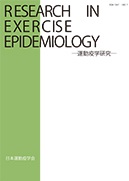Volume 14, Issue 2
Displaying 1-7 of 7 articles from this issue
- |<
- <
- 1
- >
- >|
Preface
-
2012Volume 14Issue 2 Pages 106-
Published: September 30, 2012
Released on J-STAGE: May 09, 2021
Download PDF (183K)
Review Article
-
2012Volume 14Issue 2 Pages 107-116
Published: September 30, 2012
Released on J-STAGE: May 09, 2021
Download PDF (349K) -
2012Volume 14Issue 2 Pages 118-124
Published: September 30, 2012
Released on J-STAGE: May 09, 2021
Download PDF (215K) -
2012Volume 14Issue 2 Pages 125-134
Published: September 30, 2012
Released on J-STAGE: May 09, 2021
Download PDF (743K)
Original Article
-
2012Volume 14Issue 2 Pages 135-142
Published: September 30, 2012
Released on J-STAGE: May 09, 2021
Download PDF (492K) -
2012Volume 14Issue 2 Pages 143-150
Published: September 30, 2012
Released on J-STAGE: May 09, 2021
Download PDF (551K)
Series
-
2012Volume 14Issue 2 Pages 151-160
Published: September 30, 2012
Released on J-STAGE: May 09, 2021
Download PDF (857K)
- |<
- <
- 1
- >
- >|
